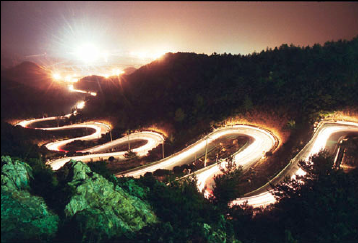4.3: Assessment
- Page ID
- 151091
\( \newcommand{\vecs}[1]{\overset { \scriptstyle \rightharpoonup} {\mathbf{#1}} } \)
\( \newcommand{\vecd}[1]{\overset{-\!-\!\rightharpoonup}{\vphantom{a}\smash {#1}}} \)
\( \newcommand{\dsum}{\displaystyle\sum\limits} \)
\( \newcommand{\dint}{\displaystyle\int\limits} \)
\( \newcommand{\dlim}{\displaystyle\lim\limits} \)
\( \newcommand{\id}{\mathrm{id}}\) \( \newcommand{\Span}{\mathrm{span}}\)
( \newcommand{\kernel}{\mathrm{null}\,}\) \( \newcommand{\range}{\mathrm{range}\,}\)
\( \newcommand{\RealPart}{\mathrm{Re}}\) \( \newcommand{\ImaginaryPart}{\mathrm{Im}}\)
\( \newcommand{\Argument}{\mathrm{Arg}}\) \( \newcommand{\norm}[1]{\| #1 \|}\)
\( \newcommand{\inner}[2]{\langle #1, #2 \rangle}\)
\( \newcommand{\Span}{\mathrm{span}}\)
\( \newcommand{\id}{\mathrm{id}}\)
\( \newcommand{\Span}{\mathrm{span}}\)
\( \newcommand{\kernel}{\mathrm{null}\,}\)
\( \newcommand{\range}{\mathrm{range}\,}\)
\( \newcommand{\RealPart}{\mathrm{Re}}\)
\( \newcommand{\ImaginaryPart}{\mathrm{Im}}\)
\( \newcommand{\Argument}{\mathrm{Arg}}\)
\( \newcommand{\norm}[1]{\| #1 \|}\)
\( \newcommand{\inner}[2]{\langle #1, #2 \rangle}\)
\( \newcommand{\Span}{\mathrm{span}}\) \( \newcommand{\AA}{\unicode[.8,0]{x212B}}\)
\( \newcommand{\vectorA}[1]{\vec{#1}} % arrow\)
\( \newcommand{\vectorAt}[1]{\vec{\text{#1}}} % arrow\)
\( \newcommand{\vectorB}[1]{\overset { \scriptstyle \rightharpoonup} {\mathbf{#1}} } \)
\( \newcommand{\vectorC}[1]{\textbf{#1}} \)
\( \newcommand{\vectorD}[1]{\overrightarrow{#1}} \)
\( \newcommand{\vectorDt}[1]{\overrightarrow{\text{#1}}} \)
\( \newcommand{\vectE}[1]{\overset{-\!-\!\rightharpoonup}{\vphantom{a}\smash{\mathbf {#1}}}} \)
\( \newcommand{\vecs}[1]{\overset { \scriptstyle \rightharpoonup} {\mathbf{#1}} } \)
\( \newcommand{\vecd}[1]{\overset{-\!-\!\rightharpoonup}{\vphantom{a}\smash {#1}}} \)
\(\newcommand{\avec}{\mathbf a}\) \(\newcommand{\bvec}{\mathbf b}\) \(\newcommand{\cvec}{\mathbf c}\) \(\newcommand{\dvec}{\mathbf d}\) \(\newcommand{\dtil}{\widetilde{\mathbf d}}\) \(\newcommand{\evec}{\mathbf e}\) \(\newcommand{\fvec}{\mathbf f}\) \(\newcommand{\nvec}{\mathbf n}\) \(\newcommand{\pvec}{\mathbf p}\) \(\newcommand{\qvec}{\mathbf q}\) \(\newcommand{\svec}{\mathbf s}\) \(\newcommand{\tvec}{\mathbf t}\) \(\newcommand{\uvec}{\mathbf u}\) \(\newcommand{\vvec}{\mathbf v}\) \(\newcommand{\wvec}{\mathbf w}\) \(\newcommand{\xvec}{\mathbf x}\) \(\newcommand{\yvec}{\mathbf y}\) \(\newcommand{\zvec}{\mathbf z}\) \(\newcommand{\rvec}{\mathbf r}\) \(\newcommand{\mvec}{\mathbf m}\) \(\newcommand{\zerovec}{\mathbf 0}\) \(\newcommand{\onevec}{\mathbf 1}\) \(\newcommand{\real}{\mathbb R}\) \(\newcommand{\twovec}[2]{\left[\begin{array}{r}#1 \\ #2 \end{array}\right]}\) \(\newcommand{\ctwovec}[2]{\left[\begin{array}{c}#1 \\ #2 \end{array}\right]}\) \(\newcommand{\threevec}[3]{\left[\begin{array}{r}#1 \\ #2 \\ #3 \end{array}\right]}\) \(\newcommand{\cthreevec}[3]{\left[\begin{array}{c}#1 \\ #2 \\ #3 \end{array}\right]}\) \(\newcommand{\fourvec}[4]{\left[\begin{array}{r}#1 \\ #2 \\ #3 \\ #4 \end{array}\right]}\) \(\newcommand{\cfourvec}[4]{\left[\begin{array}{c}#1 \\ #2 \\ #3 \\ #4 \end{array}\right]}\) \(\newcommand{\fivevec}[5]{\left[\begin{array}{r}#1 \\ #2 \\ #3 \\ #4 \\ #5 \\ \end{array}\right]}\) \(\newcommand{\cfivevec}[5]{\left[\begin{array}{c}#1 \\ #2 \\ #3 \\ #4 \\ #5 \\ \end{array}\right]}\) \(\newcommand{\mattwo}[4]{\left[\begin{array}{rr}#1 \amp #2 \\ #3 \amp #4 \\ \end{array}\right]}\) \(\newcommand{\laspan}[1]{\text{Span}\{#1\}}\) \(\newcommand{\bcal}{\cal B}\) \(\newcommand{\ccal}{\cal C}\) \(\newcommand{\scal}{\cal S}\) \(\newcommand{\wcal}{\cal W}\) \(\newcommand{\ecal}{\cal E}\) \(\newcommand{\coords}[2]{\left\{#1\right\}_{#2}}\) \(\newcommand{\gray}[1]{\color{gray}{#1}}\) \(\newcommand{\lgray}[1]{\color{lightgray}{#1}}\) \(\newcommand{\rank}{\operatorname{rank}}\) \(\newcommand{\row}{\text{Row}}\) \(\newcommand{\col}{\text{Col}}\) \(\renewcommand{\row}{\text{Row}}\) \(\newcommand{\nul}{\text{Nul}}\) \(\newcommand{\var}{\text{Var}}\) \(\newcommand{\corr}{\text{corr}}\) \(\newcommand{\len}[1]{\left|#1\right|}\) \(\newcommand{\bbar}{\overline{\bvec}}\) \(\newcommand{\bhat}{\widehat{\bvec}}\) \(\newcommand{\bperp}{\bvec^\perp}\) \(\newcommand{\xhat}{\widehat{\xvec}}\) \(\newcommand{\vhat}{\widehat{\vvec}}\) \(\newcommand{\uhat}{\widehat{\uvec}}\) \(\newcommand{\what}{\widehat{\wvec}}\) \(\newcommand{\Sighat}{\widehat{\Sigma}}\) \(\newcommand{\lt}{<}\) \(\newcommand{\gt}{>}\) \(\newcommand{\amp}{&}\) \(\definecolor{fillinmathshade}{gray}{0.9}\)1. Write an appropriate terminology in the blank.
is a semiconductor technology used to build light-sensitive electronic devices such as digital cameras and image scanners. It is the sensor used in digital cameras. The important feature is its physical size. The larger the sensor, the larger the digital image it produces.
2. Which of following explanations of ISO for digital cameras is true?
a. A higher ISO number requires more light for a proper exposure
b. A higher ISO number indicates the film is less sensitive
c. Shutter speed settings on digital cameras are the equivalent of ISO ratings on film
d. The basic sensitivity setting of most digital cameras is equivalent to ISO 100 film
3. There are two kinds of digital cameras in column 1 and appropriate features in column 2. Match the features to the appropriate camera by writing the letters next to column1. Answers may be used more than once.
| Column 1 | Column 2 |
|
1.P/S(point and shoot) camera – ( ) 2.DSLR(digital single-lens-reflex) camera – ( ) |
a. Smaller size, less weight b. External LCD c. Fast auto focus d. Huge, fast ISO range |
4. Why is it important to gently squeeze the shutter button?
5. Examine Picture 1 and Picture 2 below. The subjects in the Picture 1 are out of focus. Picture 2 shows that focus lock overrides the auto-focus and prevents it from refocusing on the background. Arrange the items in appropriate order to use focus lock to make Picture 2. ( → → → )
a. Gently squeeze the shutter button all the way down
b. Keep the finger on the button
c. Press and hold the shutter button halfway down so that camera focuses on one of the subjects
d. Slowly move the camera to compose the shot
[Picture 1] [Picture 2]
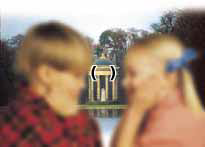
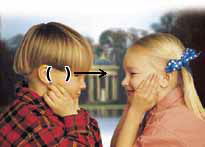
6. Of the following pictures, which one used “rule of thirds” best?
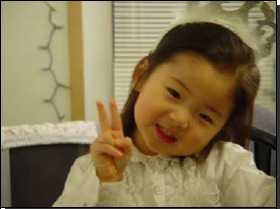
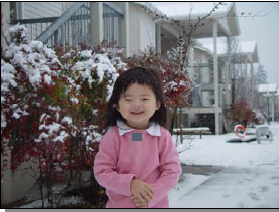
A B
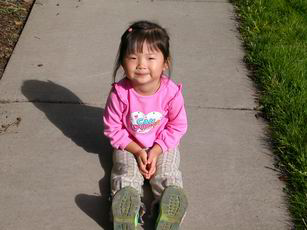

C D
7. Part 1 lists names of photo compositions. Match Part 1 with the appropriate picture in Part 2.
- Part 1
a. triangle composition ( ) b. horizontal composition ( )
c. symmetrical composition ( ) d. diagonal composition ( )
- Part 2
[Picture 1] [Picture 2]
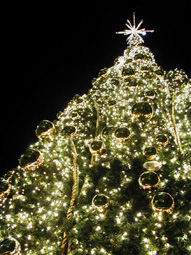
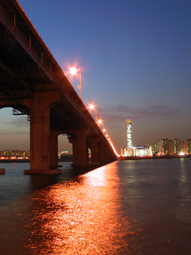
[Picture 3] [Picture 4]
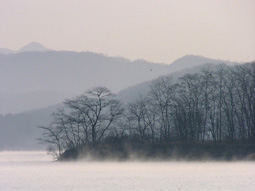
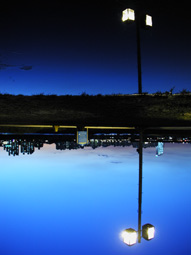
8. For which of following situations should you adjust the white balance setting of the digital camera?
a. When you review the photo through the LCD, the photo is blurring
b. When you review the photo through the LCD, the color of people has reddish hues
c. When you try to make good composition
d. When you prevent red-eye in your photo
9. When you want to make the background brighter or darker, which of following setting should you
change in your digital camera?
a. AE b. CCD c. EV d. Sync
10. The following statements are about using the flash function. Indicate if the statements are true or false
by circling the correct response.
a. Flash can be used in situations of daylight to prevent shadow (true / false)
b. Black or gray paper can be used to make flash light softer (true / false)
c. When you are taking a picture against light and far from the subject, flash is useful (true / false)
11. Which of following occurs after shutter priority is selected in digital cameras?
a. High shutter speed should be accompanied with external flash mode
b. Slow shutter speed can be used when we want to get photo freezing the action
c. The camera will automatically select aperture setting to compensate for the shutter speed
d. We can control exposure value of background with this setting
12. Select the appropriate condition when using the out focus technique.
a. The aperture setting should be made (smaller / larger)
b. You should use (zoom / AE lock) function as much as possible.
c. The distance between a subject and background should be made (closer / far)
13. Example photos in part 1 represent poor techniques for taking photos of people. Select an appropriate
used only once.
- Part 1
a.[Picture 1]( ) b.[Picture 2]( )
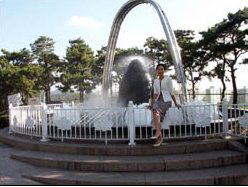

c.[Picture 3]( ) d.[Picture 4]( )
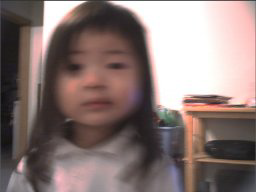
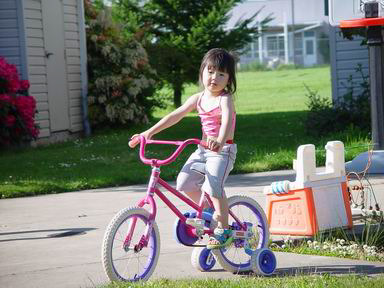
-Part 2
[Technique A]: Get more exposure using EV
[Technique B]: Getting closer to subject or subject should be closer to camera
[Technique C]: Shutter speed should be higher
[Technique D]: Following the rule of thirds
14. Which is the appropriate technique for shooting landscape?
a. It is better to use a burst mode
b. It is better to use a tripod
c. It is better to use a macro mode
d. It is better to use a red-eye reduction
15. Choose appropriate descriptions for shooting close-up photos. (Two answers should be selected)
a. It is better to use a shutter slow mode
b. It is better to use an aperture priority mode
c. It is better to use a flash priority mode
d. It is better to use a macro mode
16. Which technique can have the same effect as the illumination on the bridge in the following photo?
a. White balance should be changed
b. Flash should be used
c. Aperture should be more closed
d. Macro mode should be selected

17. Which technique should be used to make night photos as shown in the following examples?
a. Selective focusing technique should be used
b. Flash mode should be used
c. Lower number of ISO range should be selected
d. Shutter speed should be slower
